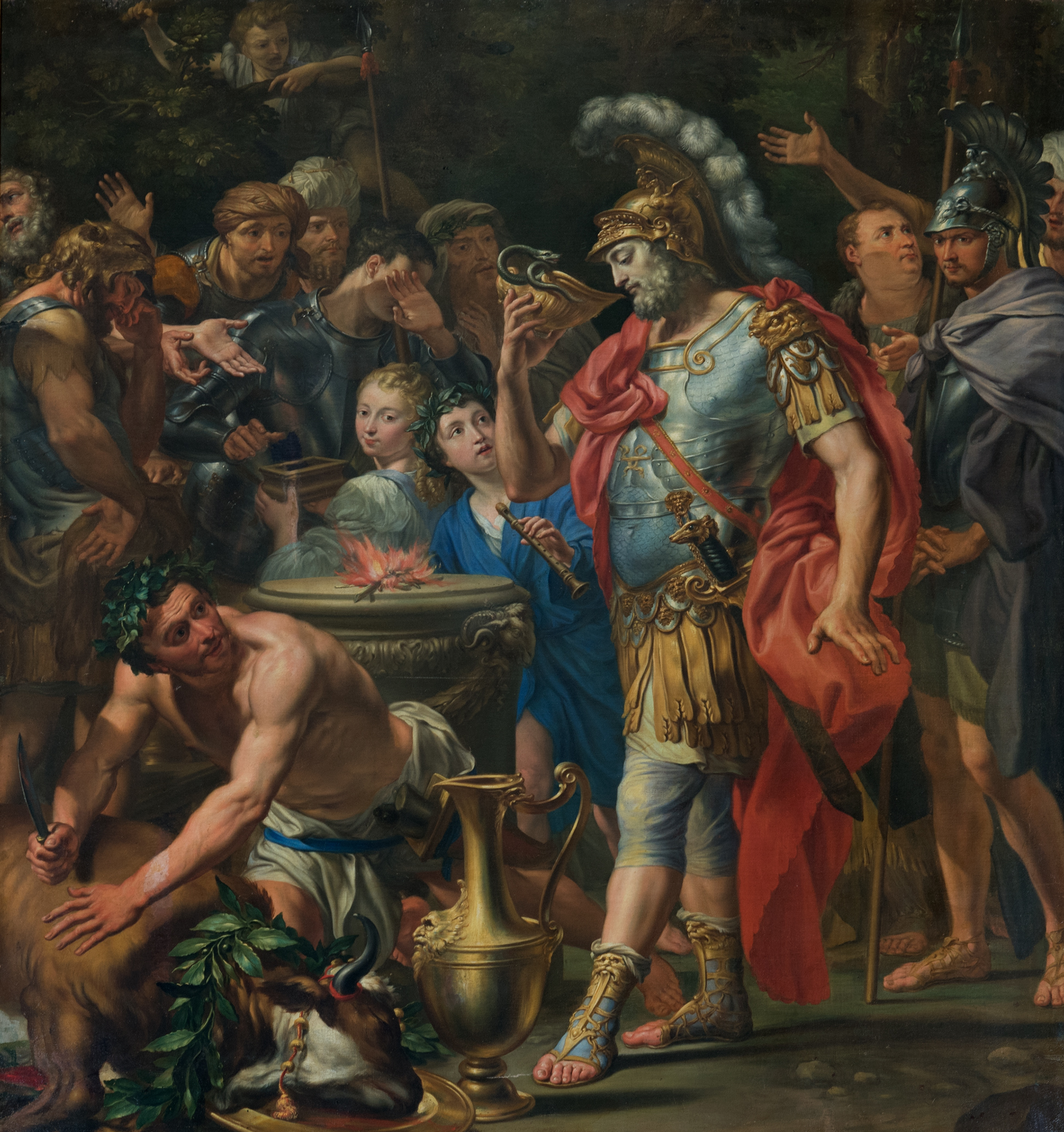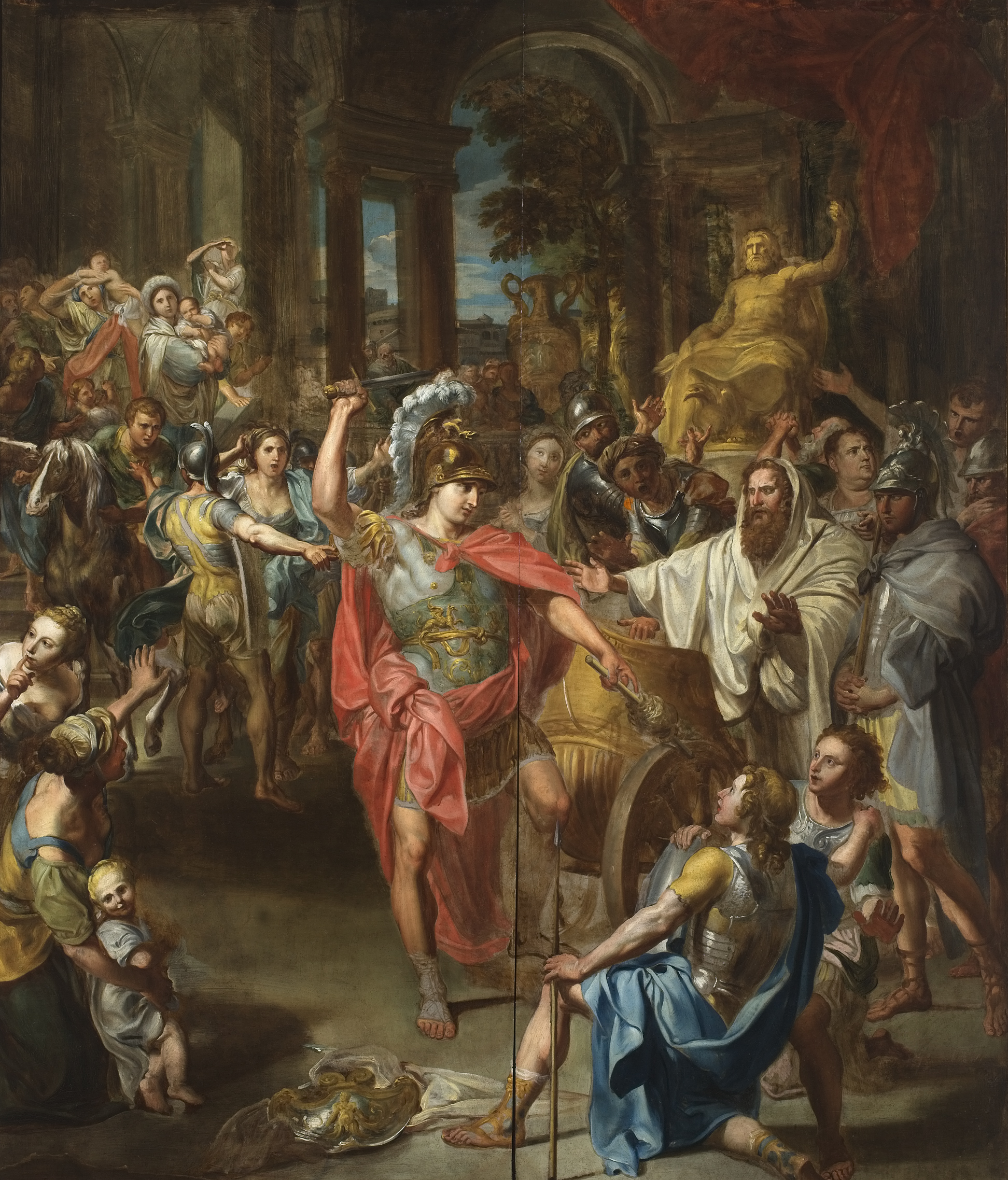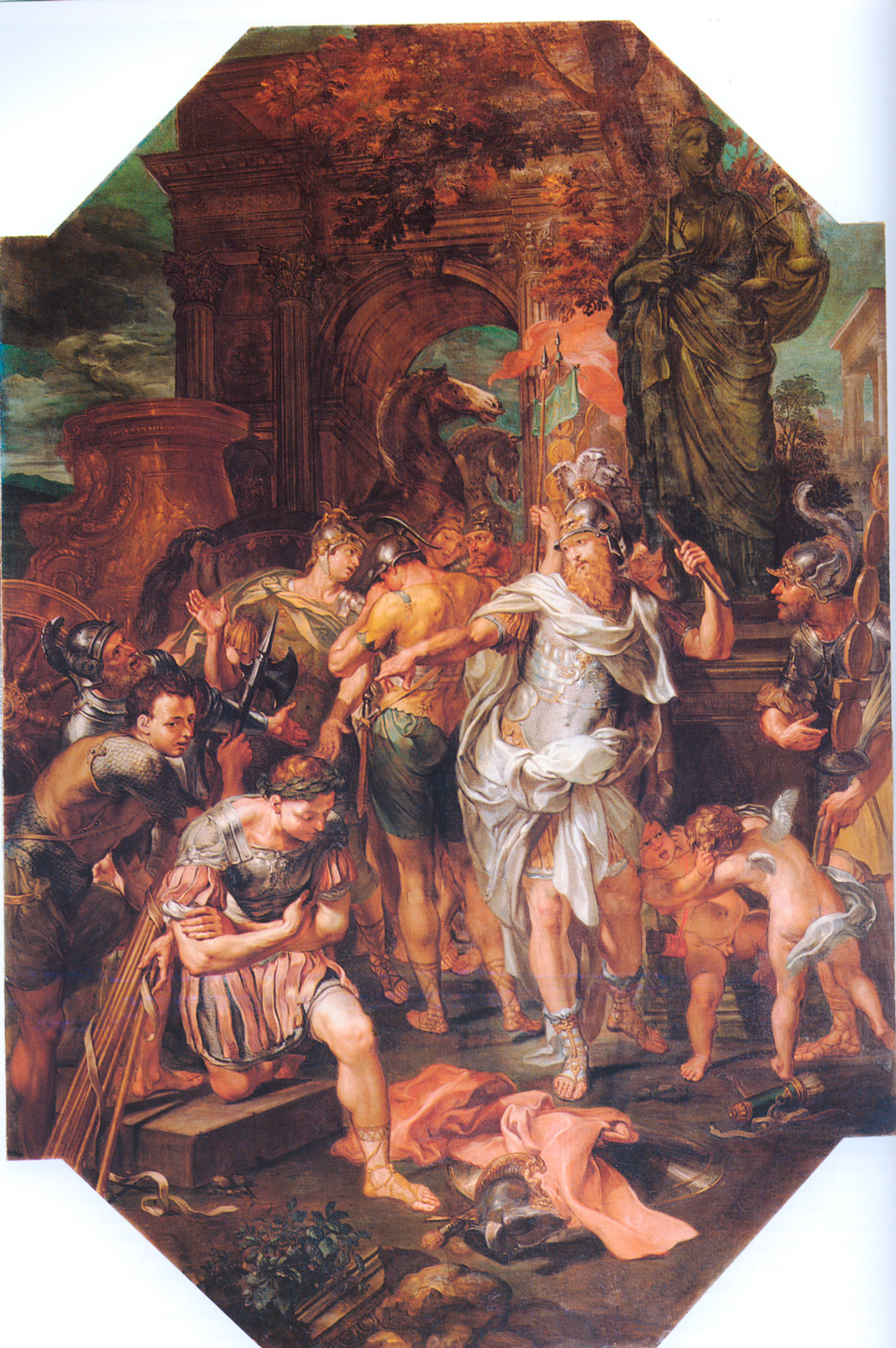The suicide of an ancient politician in a Lorenzo De Ferrari painting
Misunderstood multiple times, a painting in the Royal Palace of Turin is recognized as Lorenzo De Ferrari depicting Themistocles’s suicide
On the northern wall of the “Sala degli Staffieri” room in the Royal Palace of Turin, adjacent to the ballroom and next to the Clelia ricondotta davanti a Porsenna by Placido Costanzi (1749), is a painting from about ten years earlier whose subject and author have been misunderstood on several occasions up until now. The work has most likely been there since the building was first used, as the inventory from 1754 includes its author Lorenzo De Ferrari, mentioned as “Ab[a]te de Ferrari”, as one of those responsible for the overdoors. The mystery and misfortune of this picture is largely due to its absence from the 1777 “Catalogues Des Tableaux” (Catalog of pictures) by Pietro Paolo Wehrlin, an incomplete and unambitious list of paintings in the palace, but also because of its confusing subject: It is a rare depiction of an episode from the history of Ancient Greece, misunderstood a century later as “Hamilcar drinking the blood of the victim in confirmation of the oath against the Romans” by an unknown author.

Also absent from the “Description of the Royal Palace of Turin” published by Clemente Rovere in 1858, the canvas is mentioned as a “Pagan sacrifice” in the catalog of the memorable 1963 Piedmontese Baroque exhibition, where Andreina Griseri, a scholar of Genoese painting, believed the work to belong to the Bolognese school due to the classicist vein that permeates its composition.
About fifteen years later, Renato Roli identified the author in the Savoyard Francesco Josserme also known as L’Ange (1675-1756), a plausible hypothesis as the artist worked in Turin at the beginning of the 18th century before moving to Bologna. The attribution was first received with caution by Cristina Mossetti, who pointed out the greater quality of this piece compared to two paintings by L’Ange for the chapel dedicated to Santa Genoveffa in the Turin church of San Francesco da Paola. More recently, the same Roli attribution was rejected by Stefania De Blasi, a scholar of L’Ange who believed the hypothesis was “unconvincing and devoid of documentary footholds”, so much so as she did not include the picture in question in the final list of confirmed or even uncertain L’Ange works.
We believe this painting is the work of the slightly younger and less long-lived Genoese artist Lorenzo De Ferrari (1680-1744), the gifted son of the more known Gregorio. In his “Lives”, the 18th century historian Carlo Giuseppe Ratti reports how Lorenzo was commonly called the Abbot De’ Ferrari, a consistent custom with what is mentioned in the Royal Palace inventory of 1754. Beyond this source, what really cements the attribution is the formal quality of the painting, the work of one of the last great Baroque interpreters whose expression repeats in the Alessandro e il nodo di Gordio, recently attributed to De Ferrari.

The two paintings add up to the small list of De Ferrari canvas works, especially showing how his stay in Rome in 1734 marked a change in his oeuvre, steering away from his father’s Rococo predilection and moving closer to classicism. As Ratti mentions, in Rome Lorenzo came into contact both with two of the main exponents of the Marattesque tradition, Sebastiano Conca and Agostino Masucci, and with Marco Benefial, a late follower of the early 17th century school of Bologna.
Modern critics, who didn’t know of the two above-mentioned paintings and were rather influenced in their opinion by De Ferrari’s later paintings – above all the “Galleria Dorata” at Palazzo Carrega (1742-44) – hardly realized the influence that the Roman experience had on the artist. Works like Enea sbarca sulle sponde del Lazio formerly at Palazzo Saluzzo Granello, Giustizia di Tito Manlio Torquato, Fortezza di Muzio Scevola at Palazzo Rosso, the tondo with Enea e Didone, and the lunettes in the “Galleria Dorata” are tightly related with his recently confirmed style: they feature a limited number of figures, proximity of the scene to the eye of the viewer (the Turin work), some classicist traits (above all Vitellio’s head in the background), the more relaxed posture of the characters, and attention to details (the taurobolium).
All things considered, this oeuvre draws on the classicist model of Charles Le Brun, who had been able to best combine historical themes, chromatic sumptuousness and compositional elegance when painting at the service of Louis XIV. Although there is no reason to believe that Lorenzo De Ferrari ever visited France, his knowledge of the great French painter must have come from prints or even tapestries, sources he used to freshen his lexicon of ornamentation. If in one instance De Ferrari surely used engravings – even from Mantegna – as a model for his frescoes (the “Salotto delle Virtù Romane” at Palazzo Rosso in Genoa), it is likely he did so for other works too. It is significant to remember that the Marquis Niccolò Maria Pallavicini specifically invited the artist Domenico Piola to draw inspiration for the Alexander and Darius’s family from the “carved papers that [he] supposed [the artist] must have seen,” referring to the stories of the Macedonian leader that Le Brun himself had painted for Louis XIV – the Marquis considered the engravings even more beautiful than the paintings. Artist Francesco Trevisani, another credible Roman acquaintance of De Ferrari, also drew on those same iconographic sources for his version of the subject, later executed by many for the El Real Sitio de La Granja de San Ildefonso in Spain.
The circumstances lead us to hypothesize that De Ferrari’s client also asked him to look at the Le Brun prints for the courtly context of his own painting. What is certain is that the commission for the “Pagan Sacrifice” came directly from the court of Turin. Although without concrete basis, Ratti mentions it in his biography of De Ferrari; among the paintings made for “foreigners” he cites one where the painter “beautifully succeeded [in rendering] Themistocles in the act of drinking the blood of the bull, [a picture that] was commissioned by Count Grossocavallo Guardaroba for the Kingdom of Sardinia.”
As he personally met De Ferrari, the precious testimony of the historian should be considered reliable. It also sheds light on both the painting’s client – King Carlo Emanuele III of Savoy – and its subject: surely not the sacrifice of the Carthaginian leader Hamilcar about to leave for Spain as recorded in the inventory of 1822, nor a generic “Pagan sacrifice” as it was considered in modern times. A few details, including the snake on the cup as a symbol of the poisonous drink, or the puzzled bystanders, confirm Ratti’s claim that the picture depicts the suicide of Themistocles.
It should be mentioned that this painting already appeared in the catalog of De Ferrari’s works put together by Ezia Gavazza in 1965, but only because it was mistaken – the third misunderstanding for this unfortunate piece – for the aforementioned Alessandro e il nodo di Gordio, then in the deposits of Palazzo Bianco in Genoa, in conditions of such poor legibility not only to deceive the scholar, but also to induce her not to express any opinion on the work.

As far as the extremely rare iconography is concerned, the life of Themistocles, as reported by the historian Thucydides (5th century BC), is one of an Athenian politician who lived between the 6th and 5th centuries BC. He famously defeated Xerxes’s fleet at Salamis before having to leave his homeland to escape from the ungrateful ostracism of his fellow citizens. As a guest of Artaxerxes, the son of his ancient enemy, he was asked to lead the Persian army against Greece, a request he could not bear and consequently led him to take his life by poison. (Another account has him suffering from a lethal illness.)
Over time, the suicide version became widely accepted and confirmed by historian Diodorus Siculus (1st century BC), who also provided a noble explanation for that extreme gesture: Previously the Athenian would have convinced Artaxerxes not to wage war without him, so that by killing himself he could avoid a new campaign by the Persian against his homeland of Greece. Diodorus recounts how Themistocles arranged for the sacrifice of a bull to obtain the favor of the gods, immolating the animal and collecting his blood (believed to be poisonous in ancient times) only to gulp it down and dying immediately after in front of a few puzzled bystanders. The episode is also mentioned by Cicero (1st century BC), who stressed the image of the valiant suicidal Themistocles instead of the “banality” of lethal disease. Although Cornelius Nepos (1st century BC) and above all Plutarch (1st century AD) advanced the possibility that Themistocles’s suicide was motivated by fear of losing a battle against his compatriots, Valerius Maximus (1st century AD) rather considered the episode as one of the most powerful examples of a person’s love for their country.
In the 18th century, the Greek story must have been chosen precisely for the celebration of King Carlo Emanuele III’s loyalty to his land, the ancient politician being a model of civil virtue heroically practiced to the point of self-sacrifice. Moreover, a little known historical character like Themistocles is not a surprising picking insofar as many works commissioned by Filippo Juvarra first and later by Carlo Emanuele Cavalleri di Groscavallo for the same palace also feature rarely depicted subjects.
Especially responsible for the palace’s decorations and furnishings, Groscavallo took the role in 1737 and kept it until 1783, a period that must comprise the execution of De Ferrari’s The Suicide of Themistocles. The works in the aforementioned Palazzo Rosso cycle, datable to around 1740, remain the most effective and convincing stylistic comparison to situate The Suicide of Themistocles. While waiting to consult the account books of the Savoy court in order to verify the existence of a specific payment, it is credible that it was delivered around 1739-1740.

Even if the painting is coherent with much else Groscavallo had commissioned for the palace, it is also in line with what Juvarra had previously arranged for the various Savoyard residences. However, with respect to the origin of the painters selected up to the end of 1734 by the latter and from 1737 by the former – Naples, Rome, Bologna and Venice – the involvement of Lorenzo De Ferrari, a Genoese, is a sort of exception despite the fact that many artists from Genoa had found a flourishing market in Turin in previous decades (among others, Lorenzo’s father, Gregorio).
The exception would feel less so in the context of Juvarra’s later employer, Philip V of Spain and the Salà delle Virtù in La Granja: It is well documented how in 1735 the architect wrote from Madrid to the Neapolitan Francesco Solimena, to the Roman Francesco Trevisani, Sebastiano Conca and Agostino Masucci, to the Venetian Giovanni Battista Pittoni, to the Bolognese Donato Creti, and to the Genoese Domenico Parodi with the purpose to involve them, each with a painting, in a cycle of stories of Alexander the Great intended to celebrate precisely the moral virtues of his new client. Although Juvarra’s plan didn’t materialize, his alleged ambition to showcase all of the main painting schools in Italy in the Spanish court reflects the attitude of his successor Groscavallo in Turin. His employment of De Ferrari, by now a representative of the “international academia” (to use an expression by Andreina Griseri) thanks to his Roman experience, is coherent with the style the governor sought for the palace he was tasked to decorate.
I first want to thank Enrica Pagella, who, as director of the Royal Museums of Turin, enthusiastically accepted my proposal to study the painting that is the subject of this contribution; followed by Gelsomina Spione who assisted me with competence, friendship and patience during the research; and finally Alessandro Avanzino, Miriam Failla, Carmen García-Frias, Angelo Mazza and Tomaso Ricardi di Netro, who have made available to me texts otherwise inaccessible during a pandemic.
September 5, 2023
